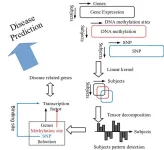(Press-News.org)
High Mountain Asia (HMA), encompassing the Tibetan Plateau and the surrounding Hindu Kush, Karakoram, and Himalayan ranges, harbors the world's third-largest amount of glacial ice. It is the source of more than 10 major Asian rivers and vital water resources for nearly 2 billion people.
Recent decades have witnessed a dipolar trend in HMA precipitation, characterized by an increase in the north but a decrease in the southeast. These changes have significant implications for water resource security and ecological equilibrium in both local and downstream regions.
Researchers from the Institute of Atmospheric Physics (IAP) of the Chinese Academy of Sciences (CAS), the Pacific Northwest National Laboratory in the U.S., the Max Planck Institute for Meteorology in Germany, and Ocean University of China have unraveled the mechanisms driving these precipitation alterations.
More notably, however, the researchers also predict that, due to air pollution control measures, the currently drying Himalayan region will transition to wetter conditions by the 2040s under medium to high greenhouse gas emission scenarios.
The study was published in Nature on Oct. 11.
The focus of the study was primarily on long-term summer precipitation changes in HMA, spanning over a decade, rather than year-to-year fluctuations. According to Dr. JIANG Jie of IAP, the study's lead author, summer HMA precipitation changes are "anchored" by two dominant patterns: a westerly-associated pattern and a monsoon-associated pattern. The former increases precipitation over the northern HMA region while decreasing it over the southeastern region. The latter corresponds to an out-of-phase variation between South Asia and the southeastern HMA region.
The researchers used various evidence from climate model simulations to reveal that uneven emissions of anthropogenic aerosols in Eurasia have weakened the jet stream and reinforced the westerly-associated precipitation pattern since the 1950s. In contrast, the monsoon-associated precipitation pattern is influenced by the interdecadal Pacific oscillation (IPO), an internal variability that fluctuates every 20 to 30 years. The recent IPO cycle, beginning in the late 1990s and transitioning from warmer-than-normal to cooler-than-normal sea surface conditions in the tropical central-eastern Pacific, has led to increased summer monsoon rainfall in South Asia and reduced precipitation over the southeastern HMA region.
Jointly influenced by these two dominant patterns, a drying trend has accelerated in the southeastern Himalaya over the past two decades. However, long-term climate model projections paint a different picture, suggesting a widespread trend of increased wetness over HMA throughout the 21st century, including the currently drying Himalayan region. Identifying the reasons behind this transition from drying to future wetting, as well as its timing, is crucial.
The researchers found that reductions in anthropogenic aerosol emissions due to clean air policies, combined with increased greenhouse gas concentrations, are responsible for the emerging wetter trend in HMA. The tipping point in precipitation regime changes, shifting from "South Drying-North Wetting" to universal wetting, will primarily be determined by alterations in anthropogenic aerosol emissions. In contrast, the impacts of greenhouses gases emissions are the same in the past seven decades and the future, favoring a general increase in precipitation.
According to Dr. JIANG, "Analyzing observed changes in HMA precipitation reveals that variations are the result of a delicate balance between anthropogenic external forcing and internal variability, such as the IPO."
Based on climate model simulations, the researchers found that this human-induced wetting over the southeastern Himalaya will exceed the precipitation changes caused by climatic internal variability in the 2040s, coinciding with a global warming of 0.6–1.1 °C compared to the present, under medium to high greenhouse gas emission scenarios.
Prof. ZHOU Tianjun noted that changes in HMA precipitation patterns in the future will add "significant complexity" to projections about HMA water resources. He therefore suggested it is important to understand the impact of aerosol reduction in shaping the region's climate and water resources.
END
The study, published today in Nature, reports the sighting of two ice giant exoplanets colliding around a sun-like star, creating a blaze of light and plumes of dust. Its findings show the bright heat afterglow and resulting dust cloud, which moved in front of the parent star dimming it over time.
The international team of astronomers was formed after an enthusiast viewed the light curve of the star and noticed something strange. It showed the system doubled in brightness at infrared wavelengths some three years before the star started to fade in visible light.
Co-lead author Dr Matthew Kenworthy, from Leiden University, ...
People with early Alzheimer’s disease have difficulty turning when walking, according to a new study using virtual reality led by UCL researchers.
The study, published in Current Biology, used a computational model to further explore the intricacies of navigational errors previously observed in Alzheimer’s disease.
Researchers, led by Professor Neil Burgess and colleagues in the Space and Memory group* at the UCL Institute of Cognitive Neuroscience, grouped participants into three categories: healthy younger participants (31 total), healthy elderly participants (36 total) and patients with mild cognitive impairment (43 total). They then asked ...
About The Study: The findings of this study of nearly 13,000 veterans with nonmetastatic castration-resistant prostate cancer suggest that differences in outcomes by race and ethnicity exist. In addition, Black and Hispanic men may have considerably improved outcomes when treated in an equal-access setting.
Authors: Kelli M. Rasmussen, M.S., of the University of Utah School of Medicine in Salt Lake City, is the corresponding author.
To access the embargoed study: Visit our For The Media website at this link https://media.jamanetwork.com/
(doi:10.1001/jamanetworkopen.2023.37272)
Editor’s Note: Please see the article for additional information, including ...
About The Study: Survivors of adolescent and young adult cancer had high rates of perceiving increased infertility risk but frequently overestimated or underestimated their risk in this study that included 785 participants. These findings suggest that counseling on infertility risk throughout survivorship may reduce misalignment between perceptions and actual risk, decrease fertility-related psychological distress, and inform family planning decisions.
Authors: H. Irene Su, M.D., M.S.C.E., ...
Researchers have developed a method that can reveal the location of errors in quantum computers, making them up to ten times easier to correct. This will significantly accelerate progress towards large-scale quantum computers capable of tackling the world’s most challenging computational problems, the researchers said.
Led by Princeton University’s Jeff Thompson, the team demonstrated a way to identify when errors occur in quantum computers more easily than ever before. This is a new direction for research ...
PHILADELPHIA – Women and those from racial and ethnic groups underrepresented in medicine (URiM) not only occupy few leadership roles in surgical departments but also tend to be clustered into certain leadership roles, according to a new analysis led by researchers from the Perelman School of Medicine at the University of Pennsylvania. These clusters of roles include vice chairs of diversity, equity, and inclusion (DEI) or wellness, where the promotion path to department chair is unclear. The report was published today in JAMA Surgery and led by ...
At a glance:
New AI tool called EVEscape uses evolutionary and biological information to predict how a virus could change to escape the immune system.
The tool successfully predicted the most concerning new variants that occurred during the COVID-19 pandemic.
Researchers say the tool can help inform the development of vaccines and therapies for SARS-CoV-2 and other rapidly mutating viruses.
The COVID-19 pandemic seemed like a never-ending parade of SARS-CoV-2 variants, each equipped with new ways to evade the immune system, leaving the world bracing for what would come next.
But what if there were a way to make predictions ...
Imagine researchers exploring a dark room with a flashlight, only able to clearly identify what falls within that single beam. When it comes to microbial communities, scientists have historically been unable to see beyond the beam — worse, they didn’t even know how big the room is.
A new study published online October 11, 2023 in Nature highlights the vast array of functional diversity of microbes through a novel approach to better understand microbial communities by looking at protein function within them. The work was led by a team of scientists at the U.S. Department of Energy ...
【Research Study】
1. Background
Multiomics3 analysis that integrates different layers of profiles altogether is challenging, since the number of variables in profile substantially differ from each other. For instance, gene expression profile and genomic DNA methylation profile are often analyzed together, however, there are only tens of thousands of genes, whereas the number of DNA methylation sites are as many as tens of millions. The numbers differ one thousand times and the number ...
University of Virginia School of Medicine researchers have obtained new insights into how African-American and Hispanic-American people’s genes influence their ability to use Omega-3 and Omega-6 fatty acids for good health. The findings are an important step toward “precision nutrition” – where a diet tailored to exactly what our bodies need can help us live longer, healthier lives.
Omega-3 and Omega-6 are “healthy fats.” We can get them from foods, but many people also take ...





